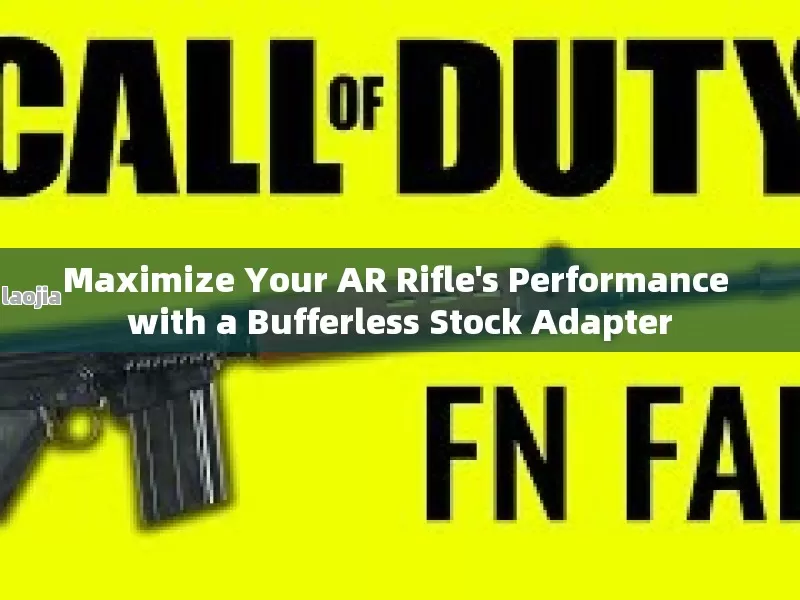Maximize Your AR Rifle's Performance with a Bufferless Stock Adapter
Explore the ultimate guide to bufferless stock adapters for AR-15 and AR-10 rifles. Learn how these adapters streamline installation, enhance aesthetics, an……
Understanding Bufferless Stock Adapters
What is a Bufferless Stock Adapter?
A bufferless stock adapter is an innovative piece of equipment specifically designed for AR-15 or AR-10 rifles. Its primary function is to enable the attachment of a stock or stabilizer directly to the rifle, omitting the traditional need for a buffer tube. This device is particularly useful for rifle configurations that accommodate all operational components within the upper receiver itself. Therefore, the need for the standard in-line buffer and buffer spring is effectively eliminated.
Key Features and Design of Bufferless Stock Adapters
Bufferless stock adapters are crafted with precision and a focus on enhanced functionality. These adapters usually thread into the standard AR rear specification of 1 3/16"-16 HSS with a right-hand thread, demonstrating compatibility with the majority of AR setups. They often feature an anti-loosening detent that secures the rear detent spring. This spring is crucial for maintaining the position of the rear takedown pin. Furthermore, the design incorporates a Picatinny rail section, usually with a 3-slot configuration, along with a 360° free swivel Quick Detach (QD) socket. This thoughtful integration ensures that the adapter is versatile and can work with a range of folding stocks or stabilizers currently popular in the market.
One of the standout aspects of these adapters is the material from which they are constructed. High-quality aluminum is generally utilized for its robust yet lightweight properties. Additionally, these adapters are treated with an anodization process to enhance their durability against wear and environmental elements.
Compatibility and Usability with AR-15 and AR-10
Bufferless stock adapters are specifically designed to be compatible with AR-15 and AR-10 rifles. This compatibility is crucial because these rifle types are prevalent among enthusiasts and professionals who appreciate modular and customizable firearms. The adapters accommodate rifles that are designed with all critical operational components housed within the upper receiver. This distinctive feature negates the dependence on a traditional buffer and buffer spring setup, providing a sleek, streamlined profile and reducing the overall weight of the firearm.
Advantages of Using a Bufferless Stock Adapter
Opting for a bufferless stock adapter introduces several advantages: - Compact Design: Without the requisite buffer tube, the overall length and weight of the rifle are reduced, leading to a more compact and maneuverable firearm. - Enhanced Aesthetics: The streamlined design not only improves how the rifle handles but also gives it a modern, sleek appearance. - Simplified Installation: Installing a stock or stabilizer is straightforward with bufferless adapters, facilitating quicker modifications and maintenance. - Cost-Effectiveness: By reducing the need for additional buffer components, the setup becomes more budget-friendly, especially appealing to those new to customizing AR rifles.
In summary, bufferless stock adapters provide a practical, innovative solution for AR-15 and AR-10 rifle owners looking to modify their firearms without the encumbrance of traditional buffer tubes. Crafted from durable materials and designed to support a wide range of stocks and stabilizers, these adapters not only enhance functionality but also improve handling and aesthetics.
Installing and Utilizing a Bufferless Stock Adapter
Step-by-Step Guide on Installing a Bufferless Stock Adapter
Installing a bufferless stock adapter on your AR-15 or AR-10 can dramatically change the handling and functionality of your rifle. The process is straightforward and requires minimal tools. Here’s how to do it:
Safety First: Ensure your rifle is unloaded. Remove the magazine and visually inspect the chamber to assure it’s clear.

Remove Existing Stock: If your rifle already has a stock attached via a traditional buffer tube, you will need to remove this first. Typically, this involves unscrewing the buffer tube and removing the stock assembly.
Prepare the Area: Clean any debris or residue from the rear of the rifle where the bufferless stock adapter will be installed. Ensure the threading and surrounding area are free of obstructions.
Align and Install Adapter: Take your bufferless stock adapter and align it to the rear threading of your AR’s receiver. Gently thread the adapter into place ensuring it is snug and secure.
Secure the Adapter: Some bufferless stock adapters come with a locking mechanism or detent to prevent loosening. Engage this feature as per the manufacturer’s instructions.
Attach Stock or Stabilizer: With your adapter securely in place, you can now attach your chosen stock or stabilizer. If using a stock with a Picatinny rail mount, slide it onto the adapter’s rail and lock it down.
Final Checks: After everything is assembled, give your rifle a thorough inspection. Check all fittings are tight and that there's no wobble or play in the newly installed components.

Ensuring Compatibility: Matching the Bufferless Adapter with Various Stocks and Stabilizers
Bufferless stock adapters are designed to be broadly compatible with various stocks and stabilizers, but it’s crucial to verify compatibility before installation. Most products will specify the types of attachments they support, typically those that mount via Picatinny rail or similar fittings. Always check product specifications and if uncertain, consult with the manufacturer or a professional gunsmith to avoid any mishaps.
Maintenance and Care for Bufferless Stock Adapters
To ensure longevity and reliability of your bufferless stock adapter, regular maintenance is essential:
Regular Cleaning: Just like any part of your rifle, the adapter should be kept clean from dirt, grime, and debris, especially after extensive use or exposure to harsh environments.
Check for Wear: Periodically inspect the adapter for any signs of wear, corrosion, or damage. Early detection can prevent malfunctions.
Lubrication: Depending on the materials and manufacturer recommendations, some moving parts may need periodic lubrication to maintain smooth operation.
Troubleshooting Common Issues During Installation
While installing a bufferless stock adapter is generally straightforward, occasionally issues may arise:

Misalignment: If the adapter isn’t threading smoothly, make sure there’s no debris and that the threads are not cross-threaded. Misalignment can strip the threads, leading to significant problems.
Loosening: If the adapter tends to loosen after some use, ensure that the locking mechanism or detent is correctly engaged. Some thread-locking adhesives might be advisable for a more secure fit.
Compatibility Issues: If your stock or stabilizer does not fit the adapter, double-check their compatibility specifications, or consider using an intermediary mounting piece that can bridge the compatibility gap.
By following this detailed guide, installing and utilizing a bufferless stock adapter can be a manageable task that enhances your rifle’s performance and handling significantly.
Maximize Your AR-15 Performance with the Best Folding Buffer Tube Assembly
Maximize Your Firearm's Performance with the Best Foldable Buffer Tube
Maximize Firearm Efficiency with the Picatinny Buffer Tube Adapter Folding
Maximize Firearm Efficiency with the Best Folding Buffer Tube Braces
Maximize Your AR-15's Potential with the Best Folding Buffer Tube
Maximize Portability with Folding AR Buffer Tubes: A Comprehensive Guide
Explore the World of Side Folding Stocks: Unlocking Compactness & Versatility in Firearms

